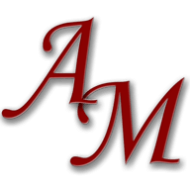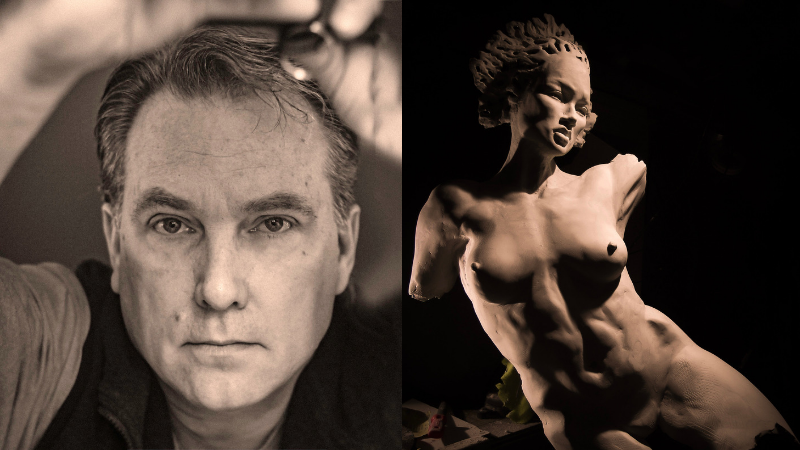“Changing the lighting on a sculpture is the same as rearranging the paint on a canvas. As sculptors we need to sculpt with this in mind. Light is literally our paintbrush”
Tim Skinner is a Canadian sculptor who also enjoys photography and collects vintage cameras. He has lived in warmer lands—Australia and Israel—, and tried, unsuccessfully, to study auto-mechanics and join Photography School. However, he did become an accomplished graphic designer and discovered his talent for sculpting a few years ago. His sense of humor precedes him and his sculptures are the best proof of this artist’s great talent.
On his Instagram account, the sculptor shares images of this works of art, his charming cats and models—Todd and Max— and special equipment like his Fujinon 75-150 f4.5. Tim’s website features a wonderful quote from famous Japanese writer, Jun’ichirō Tanizaki, that seems to guide us to his aesthetic interest: “We find beauty not in the thing itself but in the patterns of shadows, the light and the darkness, that one thing against another creates.”

In this Q&A sculptor Tim Skinner shares with PoseSpace the details of how he discovered his passion to create sculptures, who are his favorite models and explains why light is so important when displaying a sculpture:
You are a self-taught figurative sculptor. Can you tell us more about how you got into art?
I’ve always been interested in art. I really enjoyed drawing but it never came naturally for me. It wasn’t until many years into a career as a graphic designer that I accidentally discovered sculpting while playing with plasticine with my kids. It occurred to me that I was having a lot more fun than they were.
At that time I had lost interest in art and considered it to be far too self-indulgent for grown-ups, so I discounted the notion of pursuing sculpture. A lifelong friend persuaded me to persist with sculpting, his point being that one should demonstrate by example to our kids that personal growth is valuable and worthwhile —not necessarily self-serving.
That was about five or six years ago. My first sculptures were embarrassing, but I felt this was something I could get better at, with enough time and practice.
Can you tell us about the process of making your sculptures? Do you have any rituals?
I have no formal training so I’m not an exemplar by any means. I started sculpting with drywall compound, the stuff they stick to walls to cover seams. It was messy and dusty, time-consuming and awkward; but I already had it on hand.
Some time later, a friend gave me her recipe for homemade wax/clay —a fantastic modelling material. I sculpted with that for years, but mould-making and casting is time-consuming and expensive. All I want to do is sculpt. That other stuff just keeps me from sculpting.
So recently I’ve switched again —to epoxy clay. It’s like bread dough until it cures to a rock hard consistency. This is ideal for me. The epoxy clay is applied like an exoskeleton over a rough wireframe or foil armature. So basically, I rough in the general form, a section at a time, with fresh epoxy clay, then once it cures, it becomes more like a traditional stone-carving process.
Once I’ve settled on a composition, I start looking for reference material. My workspace and my methods are not well suited for live life-model work. The model would likely expire from tedium or old age before I was done. So I use general observation (people watching) and photo references.
It’s commonly believed that photo references are inadequate compared to live in-person models. I do not hold this view. I think if the life-model’s pose is recorded thoughtfully it can be a very compelling asset. That’s why I’m sold on the PoseSpace service. The high-resolution 360-degree image sequences are an essential part of my workflow. They’ve helped me to get to a level not possible with only single static images.
You also have a passion for photography and the images of your sculptures on social media are very artistic. Could you explain how you combine these arts?
Photography, when done correctly, can force us to consider lighting. Changing the lighting on a sculpture is the same as rearranging the paint on a canvas. As sculptors we need to sculpt with this in mind. Light is literally our paintbrush. I hope my photographs inspire other sculptors to become more particular about how their work is lit. It’s vitally important. So often I see fantastic sculptures ruined in hideous ways by thoughtless light. I always like to see a photo of my work in a client’s home in order to verify that they’ve lit it properly. If someone rearranged the lines on a drawing, the artist would go bonkers. Sculptors don’t seem to be given nor do they expect that same consideration. I hope my photos help to drive that point home.

Do you have a favorite PoseSpace.com model?
I rarely rely on one pose sequence for any given sculpture. Usually a few. The gesture from one model and the musculature from another perhaps. My Library of PoseSpace downloads has a few poses by AnaIv and also KeiraG. That is not by mistake. If either of these models has something approximating the pose I require then that’s what I will choose. Both AnaIv and KeiraG have outstanding muscular definition. That helps me to accurately transfer their musculature to my armature. I think it helps me to concentrate my study on one or two models generally, because that familiarity helps when I have to extrapolate how the figure would look when I inevitably go off-script.
What challenges do you face working with the nude figure?
Absolutely none. Everyone is very supportive and encouraging.
What advice do you have for young artists who have an interest in sculpture?
I’m not a commercially successful sculptor, so any advice I might have relates to an artistic pursuit rather than a career pursuit. Of my sculptures, the ones that seem to resonate the most with people are the pieces I made by indulging my own desire. So-called “legitimate” subjects and processes should be viewed as suggestions. Never take credit for mistakes that turn out well. Encourage people to handle your sculpture. They are objects. The experience is enriched exponentially when people touch the form.
Instagram: https://www.instagram.com/tim_canadian_sculptor/
Youtube Channel: https://www.youtube.com/user/timskinnercanada/
Interview by Andrea

